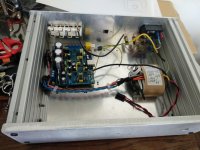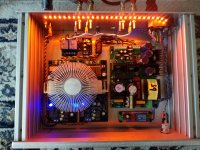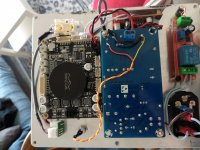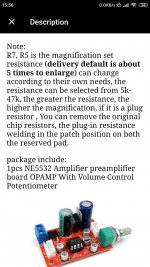would this work as a buffer for the L25D?
I have a bunch of them kicking around and I use one in the sub amp.
aliexpress.com/item/4000081857155.html
Edit: never mind this increases the gain I guess. Might still be worth a try until I find something better
I have a bunch of them kicking around and I use one in the sub amp.
aliexpress.com/item/4000081857155.html
Edit: never mind this increases the gain I guess. Might still be worth a try until I find something better
Last edited:
Still no Windows volume control though, but I've read that windows volume control messes up the bitrate anyway.
This is mostly audiophile OCD. Windows and macOS computer volume controls operate on the audio data being passed through them. So when the turn down the volume, they're modifying the data so that the volume change is applied, and the output of the DAC is reduced. Audiophiles have a problem with something messing with their pure data, so if a Windows volume control results in data output that isn't "bit perfect", it's a horrible sin.
But as I said, largely just OCD. There are two parts of the reality of this. If all the VC did was scale data linearly, yeah that might be an issue. But for decades now we've had floating-point math DSP. It's used in every digital recording system, mixing consoles, equalizers, dynamics processors, and the list goes on. That "pure" bit-perfect data is already nothing like the original recording laid down. Just the mixing process changes everything, and of course, so do the other processes listed above. So applying a gain change, another FP DSP process, really isn't a big deal, the data has already been altered a thousand different ways by the time you get your hands on it. Another volume control is no big deal.
Where we run into actual problems is when there are multiple volume controls chained one after another, both in the PC and outside of it. Windows has multiple ways to affect volume. A player my have a VC, then the Windows sound card has a VC, and so on. Then there's speaker volume controls, or amps, or external DACs, each with a volume control. They can actually be set in a way that raises the noise floor, and they can be set so they do very little bad. But it's hard to know without examining all the possibilities, which most users won't take the time to do. Because the PC is a noisy environment already, messing around with volume multiple times can hurt the signal to noise ratio. But, get it right, and the VC does work just fine. It has the added advantage of doing the identical VC to both channels, which very few physical pots can match.
Window volume controls (as well as macOS) do not change the bit rate. However, the PC sound card might, and the VC has nothing to do with it. Sound Settings will assign a default bit depth and sampling frequency, and convert everything going through it to that. The resample does very little damage, though. And again, if and audiophile knows his 192kHz file is being down-sampled to 48kHz in the sound card, he'll freak out, but mostly for no reason. It's one of those things that if known about, the knowledge alone will make the user thing the sound has been degraded. There's also no good way to perform a controlled DBT on the process, so you take what you get. Yes, it's better not to resample, yes it's better not to apply unnecessary DSP, but the reality is, the do mostly work just fine.
Audiophile OCD, that's a great way to describe it. I had a hunch this would be the case. I'm not too concerned with the software side just yet. Most of the time I stream music through spotify and such. Maybe in the future I'll have a carefully curated library of lossless flaccies, but right now I don't.
I've done some research into the L25D amplifier modules that I use. It turns out they have a voltage gain of 40, which is very high. This might explain why I have to turn down all voltage control both on the hardware and software side to even have bearable listening levels. I will swap out the gain resistor for one that lowers the gain down to 20. This will also bring it much more to the volume of my little sub.
I will also do the splitting of the DAC outputs through 1k resistors as previously suggested.
From there on I have 2 options:
Option 1:
10k volume pot as main system volume on the DAC outputs.
The unity gain buffer you suggested before only the L25D amps, mounted inside their enclosure. Connected to the auxilary 15-0-15VDC of its PS.
www.aliexpress.com/i/32978492532
Option 2:
This preamp by LJM. My DAC and power amps are also from the design of LJM, and I am very satisfied with them.
www.aliexpress.com/item/32792865895
This preamp will be installed in the DAC enclosure where there is still space for the module and a dedicated transformer.
In this case the sub amp and the power amps share the same buffer preamp.
Just to make things a little clearer, here are pictures of the DAC build, L25D power amps(with fully functional christmas lights), and sub plate amp.
I've done some research into the L25D amplifier modules that I use. It turns out they have a voltage gain of 40, which is very high. This might explain why I have to turn down all voltage control both on the hardware and software side to even have bearable listening levels. I will swap out the gain resistor for one that lowers the gain down to 20. This will also bring it much more to the volume of my little sub.
I will also do the splitting of the DAC outputs through 1k resistors as previously suggested.
From there on I have 2 options:
Option 1:
10k volume pot as main system volume on the DAC outputs.
The unity gain buffer you suggested before only the L25D amps, mounted inside their enclosure. Connected to the auxilary 15-0-15VDC of its PS.
www.aliexpress.com/i/32978492532
Option 2:
This preamp by LJM. My DAC and power amps are also from the design of LJM, and I am very satisfied with them.
www.aliexpress.com/item/32792865895
This preamp will be installed in the DAC enclosure where there is still space for the module and a dedicated transformer.
In this case the sub amp and the power amps share the same buffer preamp.
Just to make things a little clearer, here are pictures of the DAC build, L25D power amps(with fully functional christmas lights), and sub plate amp.
Attachments
Last edited:
If you expect to hit the full rated output power from a standard line level source, 40 is correct. Clearly that's not what you want though.I've done some research into the L25D amplifier modules that I use. It turns out they have a voltage gain of 40, which is very high.
The link is broken.This might explain why I have to turn down all voltage control both on the hardware and software side to even have bearable listening levels. I will swap out the gain resistor for one that lowers the gain down to 20. This will also bring it much more to the volume of my little sub.
I will also do the splitting of the DAC outputs through 1k resistors as previously suggested.
From there on I have 2 options:
Option 1:
10k volume pot as main system volume on the DAC outputs.
The unity gain buffer you suggested before only the L25D amps, mounted inside their enclosure. Connected to the auxilary 15-0-15VDC of its PS.
www.aliexpress.com/i/32978492532
Put the buffer in the DAC box, not the PA box.
Broken link again.Option 2:
This preamp by LJM. My DAC and power amps are also from the design of LJM, and I am very satisfied with them.
www.aliexpress.com/item/32792865895
This preamp will be installed in the DAC enclosure where there is still space for the module and a dedicated transformer.
In this case the sub amp and the power amps share the same buffer preamp.
If you get me a good link to the preamp I'll take a look. Preamps usually have gain, which it seems you don't want?
All buffering, preamps, line drivers, whatever, should be inside the DAC box. Volume controls should always be buffered.
oops I messed up the links. First one, the one you recommended:
DYKB HIFI NE5534 DC Buffer Stereo OP AMP Preamplifier Preamp Board support OPA627 AD847 AD797 OPA637 Single op amp Module| | - AliExpress
Downside to this one is that it needs a dual DC power supply, which I have in my power amp enclosure. But I guess I could just as well get a separate dual output DC power supply for it and put it in the chassis together with the DAC.
The preamp by LJM:
NEW Assembled LJM Audio P8 Mini Preamplifier Board|preamplifier board|mini preamplifierljm audio - AliExpress
This does indeed amplify the signal, but if I compensate with gain setting on the power amp modules, it might not matter.
DYKB HIFI NE5534 DC Buffer Stereo OP AMP Preamplifier Preamp Board support OPA627 AD847 AD797 OPA637 Single op amp Module| | - AliExpress
Downside to this one is that it needs a dual DC power supply, which I have in my power amp enclosure. But I guess I could just as well get a separate dual output DC power supply for it and put it in the chassis together with the DAC.
The preamp by LJM:
NEW Assembled LJM Audio P8 Mini Preamplifier Board|preamplifier board|mini preamplifierljm audio - AliExpress
This does indeed amplify the signal, but if I compensate with gain setting on the power amp modules, it might not matter.
This is the problem with building a system with separate, unrelated modules rather than a complete system design.
IF you're using the DAC assembly as the system control center (traditionally a job for a preamp with input selection, volume, balance, tone, etc., and output intended to properly drive power amps), then all the volume control and buffering should be in the DAC box. The amp gain is high because it's a 250Wpc amp. Change it if you like, but realize if you do you won't ever be able to drive it to full output. That's not likely a problem, almost nobody needs all that power. Most don't even listen at 10Wpc. 100Wpc is actually more than enough in most systems, 50wpc fine for nearly most.
I would compensate for all gain at the amps. That lets you drive a healthy signal down the cable to the amp, and there's a small advantage to that.
The Preamp by LJM...what's driving me a little nuts here is the lack of documentation. It's a simple circuit, two opamps Ics...but why all the secrecy? He sands off the markings on the chips, you can't really trace the circuit from the bottom view of the board, what's the big deal? It's not like there's something special about it, anybody can build this on a perf board. But anyway, with the preamp you might...might...be able to drive your amps with simple built-out resistors. But since we don't know what the chips are or how they're used, there's an unknown.
IF you're using the DAC assembly as the system control center (traditionally a job for a preamp with input selection, volume, balance, tone, etc., and output intended to properly drive power amps), then all the volume control and buffering should be in the DAC box. The amp gain is high because it's a 250Wpc amp. Change it if you like, but realize if you do you won't ever be able to drive it to full output. That's not likely a problem, almost nobody needs all that power. Most don't even listen at 10Wpc. 100Wpc is actually more than enough in most systems, 50wpc fine for nearly most.
I would compensate for all gain at the amps. That lets you drive a healthy signal down the cable to the amp, and there's a small advantage to that.
The Preamp by LJM...what's driving me a little nuts here is the lack of documentation. It's a simple circuit, two opamps Ics...but why all the secrecy? He sands off the markings on the chips, you can't really trace the circuit from the bottom view of the board, what's the big deal? It's not like there's something special about it, anybody can build this on a perf board. But anyway, with the preamp you might...might...be able to drive your amps with simple built-out resistors. But since we don't know what the chips are or how they're used, there's an unknown.
In that case I will definetly go for a 10k pot followed by the NE5534 unity gain buffer, powered by a seperate power supply.
In that case I will definetly go for a 10k pot followed by the NE5534 unity gain buffer, powered by a seperate power supply.
OK, but the 5534 requires external compensation for unity gain. Not a huge deal, 22pf. However, the 5532, essentially a dual 5534, is internally comped for unity gain. Lower parts count.
OK, but the 5534 requires external compensation for unity gain. Not a huge deal, 22pf. However, the 5532, essentially a dual 5534, is internally comped for unity gain. Lower parts count.
So if the NE5532 is preferred over NE5534, I could just use one of these?
aliexpress.com/item/4000081857155.html
Attachments
It's seems like I can easily remove the gain resistors r7 and r5. Then add 5k ohm through hole resistors. Still with no further documentation I have no idea what that makes the gain.
The stock resistors measure 15k
The stock resistors measure 15k
Attachments
- Home
- Source & Line
- Analog Line Level
- quality loss when connecting multiple amplifiers to one source





